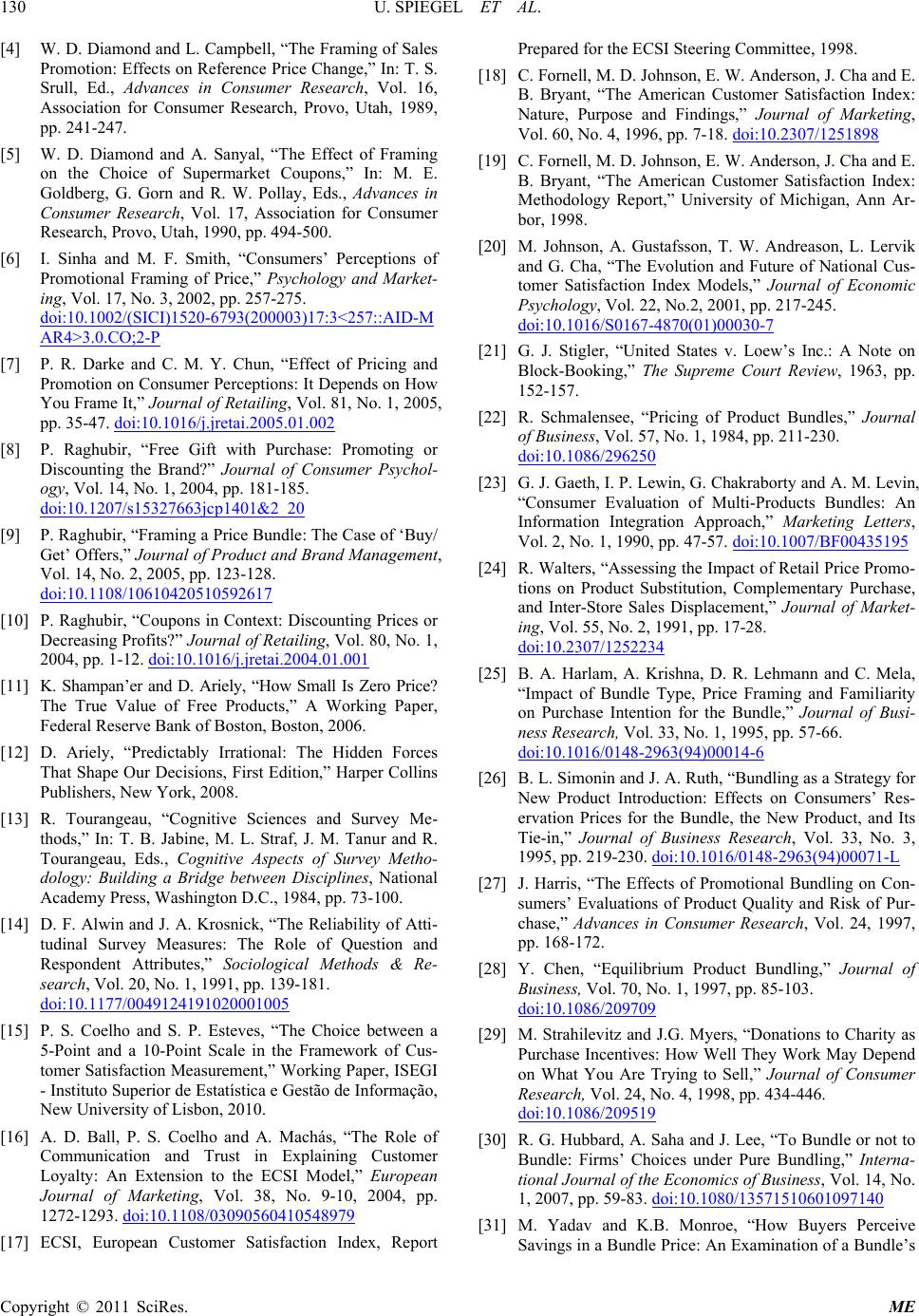
U. SPIEGEL ET AL.
Copyright © 2011 SciRes. ME
[4] W. D. Diamond and L. Campbell, “The Framing of Sales
Promotion: Effects on Reference Price Change,” In: T. S.
Srull, Ed., Advances in Consumer Research, Vol. 16,
Association for Consumer Research, Provo, Utah, 1989,
pp. 241-247.
[5] W. D. Diamond and A. Sanyal, “The Effect of Framing
on the Choice of Supermarket Coupons,” In: M. E.
Goldberg, G. Gorn and R. W. Pollay, Eds., Advances in
Consumer Research, Vol. 17, Association for Consumer
Research, Provo, Utah, 1990, pp. 494-500.
[6] I. Sinha and M. F. Smith, “Consumers’ Perceptions of
Promotional Framing of Price,” Psychology and Market-
ing, Vol. 17, No. 3, 2002, pp. 257-275.
doi:10.1002/(SICI)1520-6793(200003)17:3<257::AID-M
AR4>3.0.CO;2-P
[7] P. R. Darke and C. M. Y. Chun, “Effect of Pricing and
Promotion on Consumer Perceptions: It Depends on How
You Frame It,” Journal of Retailing, Vol. 81, No. 1, 2005,
pp. 35-47. doi:10.1016/j.jretai.2005.01.002
[8] P. Raghubir, “Free Gift with Purchase: Promoting or
Discounting the Brand?” Journal of Consumer Psychol-
ogy, Vol. 14, No. 1, 2004, pp. 181-185.
doi:10.1207/s15327663jcp1401&2_20
[9] P. Raghubir, “Framing a Price Bundle: The Case of ‘Buy/
Get’ Offers,” Journal of Product and Brand Management,
Vol. 14, No. 2, 2005, pp. 123-128.
doi:10.1108/10610420510592617
[10] P. Raghubir, “Coupons in Context: Discounting Prices or
Decreasing Profits?” Journal of Retailing, Vol. 80, No. 1,
2004, pp. 1-12. doi:10.1016/j.jretai.2004.01.001
[11] K. Shampan’er and D. Ariely, “How Small Is Zero Price?
The True Value of Free Products,” A Working Paper,
Federal Reserve Bank of Boston, Boston, 2006.
[12] D. Ariely, “Predictably Irrational: The Hidden Forces
That Shape Our Decisions, First Edition,” Harper Collins
Publishers, New York, 2008.
[13] R. Tourangeau, “Cognitive Sciences and Survey Me-
thods,” In: T. B. Jabine, M. L. Straf, J. M. Tanur and R.
Tourangeau, Eds., Cognitive Aspects of Survey Metho-
dology: Building a Bridge between Disciplines, National
Academy Press, Washington D.C., 1984, pp. 73-100.
[14] D. F. Alwin and J. A. Krosnick, “The Reliability of Atti-
tudinal Survey Measures: The Role of Question and
Respondent Attributes,” Sociological Methods & Re-
search, Vol. 20, No. 1, 1991, pp. 139-181.
doi:10.1177/0049124191020001005
[15] P. S. Coelho and S. P. Esteves, “The Choice between a
5-Point and a 10-Point Scale in the Framework of Cus-
tomer Satisfaction Measurement,” Working Paper, ISEGI
- Instituto Superior de Estatística e Gestão de Informação,
New University of Lisbon, 2010.
[16] A. D. Ball, P. S. Coelho and A. Machás, “The Role of
Communication and Trust in Explaining Customer
Loyalty: An Extension to the ECSI Model,” European
Journal of Marketing, Vol. 38, No. 9-10, 2004, pp.
1272-1293. doi:10.1108/03090560410548979
[17] ECSI, European Customer Satisfaction Index, Report
Prepared for the ECSI Steering Committee, 1998.
[18] C. Fornell, M. D. Johnson, E. W. Anderson, J. Cha and E.
B. Bryant, “The American Customer Satisfaction Index:
Nature, Purpose and Findings,” Journal of Marketing,
Vol. 60, No. 4, 1996, pp. 7-18. doi:10.2307/1251898
[19] C. Fornell, M. D. Johnson, E. W. Anderson, J. Cha and E.
B. Brya nt, “The American Customer Satisfaction Index:
Methodology Report,” University of Michigan, Ann Ar-
bor, 1998.
[20] M. Johnson, A. Gustafsson, T. W. Andreason, L. Lervik
and G. Cha, “The Evolution and Future of National Cus-
tomer Satisfaction Index Models,” Journal of Economic
Psychology, Vol. 22, No.2, 2001, pp. 217-245.
doi:10.1016/S0167-4870(01)00030-7
[21] G. J. Stigler, “United States v. Loew’s Inc.: A Note on
Block-Booking,” The Supreme Court Review, 1963, pp.
152-157.
[22] R. Schmalensee, “Pricing of Product Bundles,” Journal
of Business, Vol. 57, No. 1, 1984, pp. 211-230.
doi:10.1086/296250
[23] G. J. Gaeth, I. P. Lewin, G. Chakraborty and A. M. Levin,
“Consumer Evaluation of Multi-Products Bundles: An
Information Integration Approach,” Marketing Letters,
Vol. 2, No. 1, 1990, pp. 47-57. doi:10.1007/BF00435195
[24] R. Walters, “Assessing the Impact of Retail Pri ce Promo-
tions on Product Substitution, Complementary Purchase,
and Inter-Store Sales Displacement,” Journal of Market-
ing, Vol. 55, No. 2, 1991, pp. 17-28.
doi:10.2307/1252234
[25] B. A. Harlam, A. Krishna, D. R. Lehmann and C. Mela,
“Impact of Bundle Type, Price Framing and Familiarity
on Purchase Intention for the Bundle,” Journal of Busi-
ness Research, Vol. 33, No. 1, 1995, pp. 57-66.
doi:10.1016/0148-2963(94)00014-6
[26] B. L. Simonin and J. A. Ruth, “Bundling as a Strategy for
New Product Introduction: Effects on Consumers’ Res-
ervation Prices for the Bundle, the New Product, and Its
Tie-in,” Journal of Business Research, Vol. 33, No. 3,
1995, pp. 219-230. doi:10.1016/0148-2963(94)00071-L
[27] J. Harris, “The Effects of Promotional Bundling on Con-
sumers’ Evaluations of Product Quality and Risk of Pur-
chase,” Advances in Consumer Research, Vol. 24, 1997,
pp. 168-172.
[28] Y. Chen, “Equilibrium Product Bundling,” Journal of
Business, Vol . 70, No. 1, 1997, pp. 85-103.
doi:10.1086/209709
[29] M. Strahilevitz and J.G. Myers, “Donations to Charity as
Purchase Incentives: How Well They Work May Depend
on What You Are Trying to Sell,” Journal of Consumer
Research, Vol. 24, No. 4, 1998, pp. 434-446.
doi:10.1086/209519
[30] R. G. Hubbard, A. Saha and J. Lee, “To Bundle or not to
Bundle: Firms’ Choices under Pure Bundling,” Interna-
tional Journal of the Economics of Business, Vol. 14, No.
1, 2007, pp. 59-83. doi:10.1080/13571510601097140
[31] M. Yadav and K.B. Monroe, “How Buyers Perceive
Savings in a Bundle Price: An Examination of a Bundle’s